snow chains INFINITI QX50 2019 Owner's Manual
[x] Cancel search | Manufacturer: INFINITI, Model Year: 2019, Model line: QX50, Model: INFINITI QX50 2019Pages: 573, PDF Size: 7.4 MB
Page 266 of 573
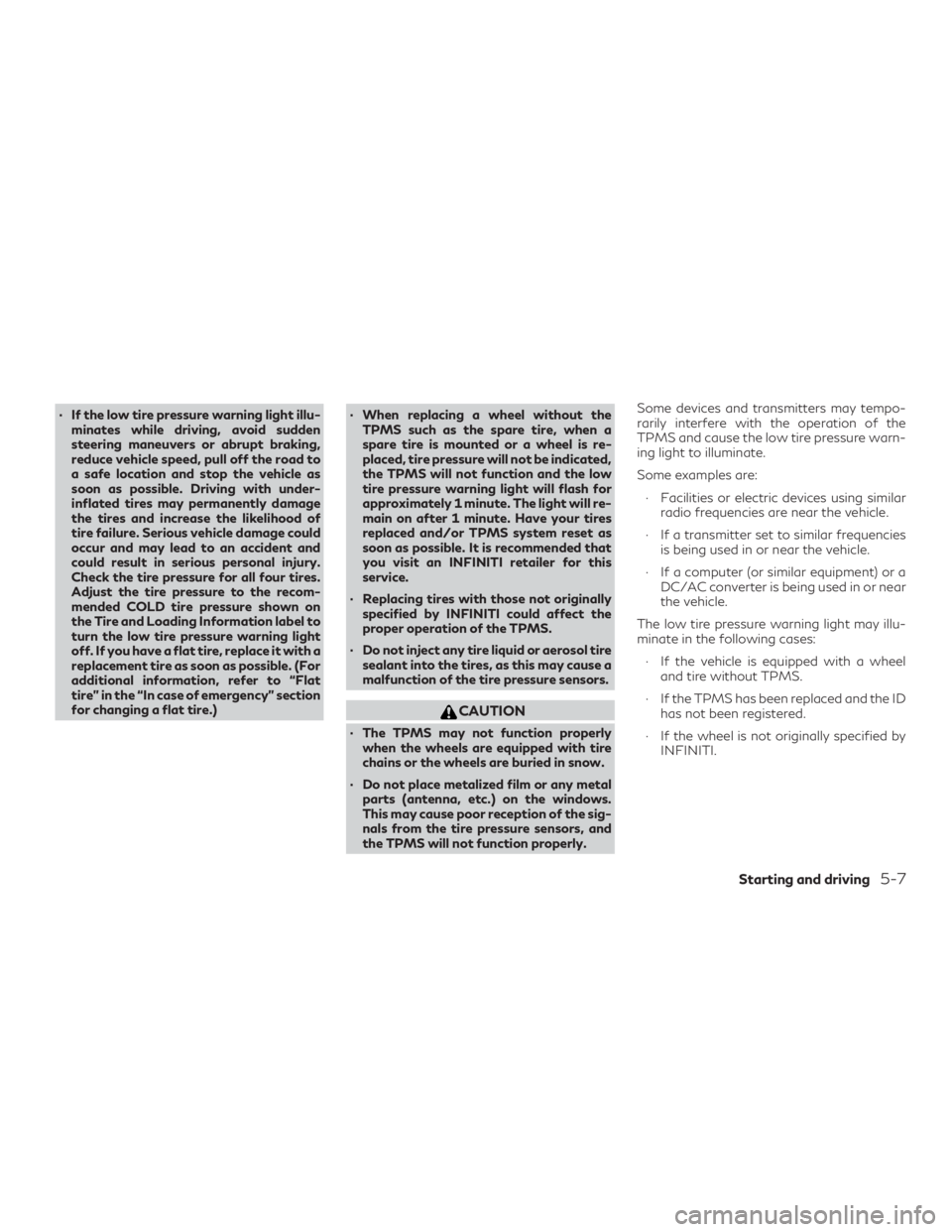
∙ If the low tire pressure warning light illu-minates while driving, avoid sudden
steering maneuvers or abrupt braking,
reduce vehicle speed, pull off the road to
a safe location and stop the vehicle as
soon as possible. Driving with under-
inflated tires may permanently damage
the tires and increase the likelihood of
tire failure. Serious vehicle damage could
occur and may lead to an accident and
could result in serious personal injury.
Check the tire pressure for all four tires.
Adjust the tire pressure to the recom-
mended COLD tire pressure shown on
the Tire and Loading Information label to
turn the low tire pressure warning light
off. If you have a flat tire, replace it with a
replacement tire as soon as possible. (For
additional information, refer to “Flat
tire” in the “In case of emergency” section
for changing a flat tire.) ∙ When replacing a wheel without the
TPMS such as the spare tire, when a
spare tire is mounted or a wheel is re-
placed, tire pressure will not be indicated,
the TPMS will not function and the low
tire pressure warning light will flash for
approximately 1 minute. The light will re-
main on after 1 minute. Have your tires
replaced and/or TPMS system reset as
soon as possible. It is recommended that
you visit an INFINITI retailer for this
service.
∙ Replacing tires with those not originally specified by INFINITI could affect the
proper operation of the TPMS.
∙ Do not inject any tire liquid or aerosol tire sealant into the tires, as this may cause a
malfunction of the tire pressure sensors.
CAUTION
∙ The TPMS may not function properlywhen the wheels are equipped with tire
chains or the wheels are buried in snow.
∙ Do not place metalized film or any metal parts (antenna, etc.) on the windows.
This may cause poor reception of the sig-
nals from the tire pressure sensors, and
the TPMS will not function properly. Some devices and transmitters may tempo-
rarily interfere with the operation of the
TPMS and cause the low tire pressure warn-
ing light to illuminate.
Some examples are:
∙ Facilities or electric devices using similar radio frequencies are near the vehicle.
∙ If a transmitter set to similar frequencies is being used in or near the vehicle.
∙ If a computer (or similar equipment) or a DC/AC converter is being used in or near
the vehicle.
The low tire pressure warning light may illu-
minate in the following cases: ∙ If the vehicle is equipped with a wheel and tire without TPMS.
∙ If the TPMS has been replaced and the ID has not been registered.
∙ If the wheel is not originally specified by INFINITI.
Starting and driving5-7
Page 295 of 573
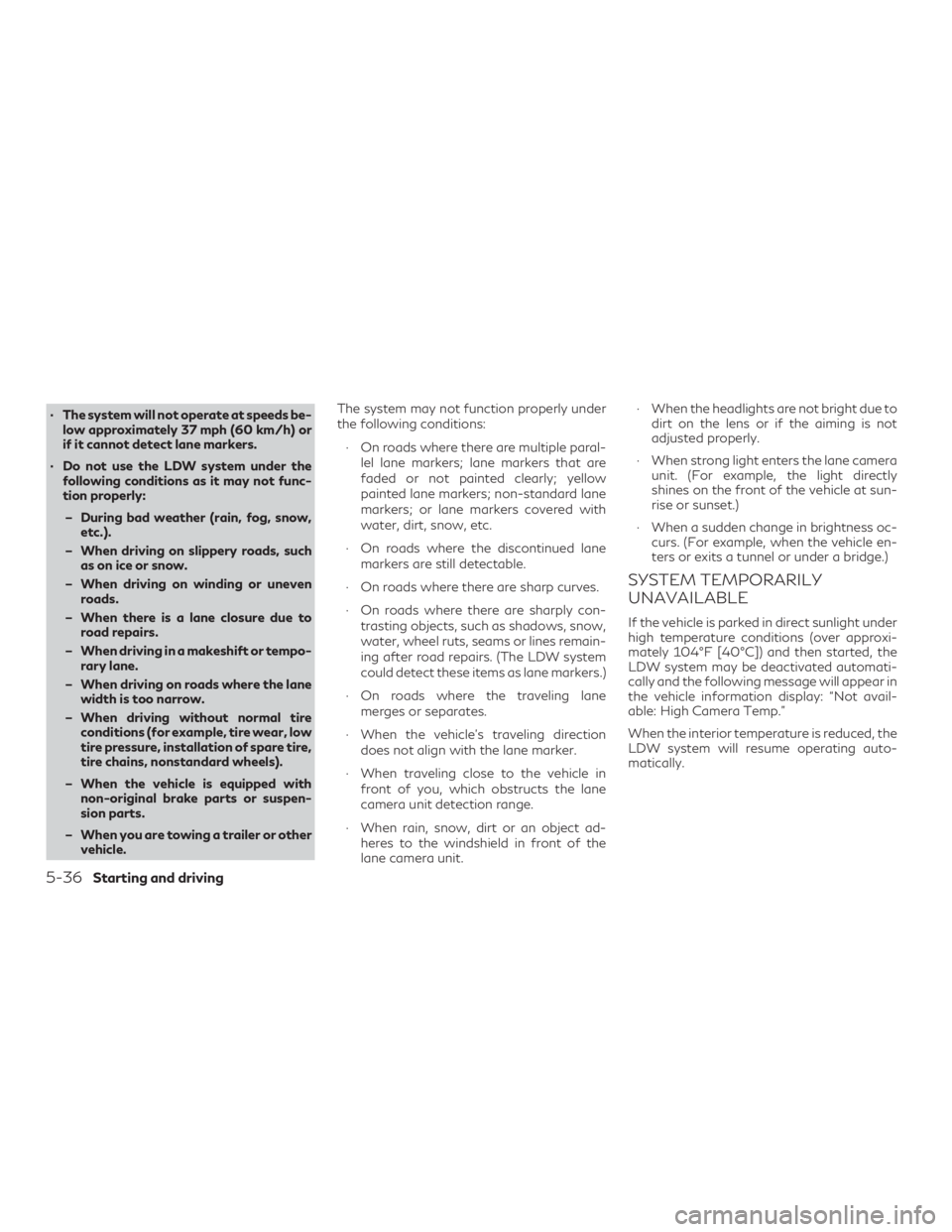
∙ The system will not operate at speeds be-low approximately 37 mph (60 km/h) or
if it cannot detect lane markers.
∙ Do not use the LDW system under the following conditions as it may not func-
tion properly:
– During bad weather (rain, fog, snow, etc.).
– When driving on slippery roads, such as on ice or snow.
– When driving on winding or uneven roads.
– When there is a lane closure due to road repairs.
– When driving in a makeshift or tempo- rary lane.
– When driving on roads where the lane width is too narrow.
– When driving without normal tire conditions (for example, tire wear, low
tire pressure, installation of spare tire,
tire chains, nonstandard wheels).
– When the vehicle is equipped with non-original brake parts or suspen-
sion parts.
– When you are towing a trailer or other vehicle. The system may not function properly under
the following conditions:
∙ On roads where there are multiple paral- lel lane markers; lane markers that are
faded or not painted clearly; yellow
painted lane markers; non-standard lane
markers; or lane markers covered with
water, dirt, snow, etc.
∙ On roads where the discontinued lane markers are still detectable.
∙ On roads where there are sharp curves.
∙ On roads where there are sharply con- trasting objects, such as shadows, snow,
water, wheel ruts, seams or lines remain-
ing after road repairs. (The LDW system
could detect these items as lane markers.)
∙ On roads where the traveling lane merges or separates.
∙ When the vehicle’s traveling direction does not align with the lane marker.
∙ When traveling close to the vehicle in front of you, which obstructs the lane
camera unit detection range.
∙ When rain, snow, dirt or an object ad- heres to the windshield in front of the
lane camera unit. ∙ When the headlights are not bright due to
dirt on the lens or if the aiming is not
adjusted properly.
∙ When strong light enters the lane camera unit. (For example, the light directly
shines on the front of the vehicle at sun-
rise or sunset.)
∙ When a sudden change in brightness oc- curs. (For example, when the vehicle en-
ters or exits a tunnel or under a bridge.)
SYSTEM TEMPORARILY
UNAVAILABLE
If the vehicle is parked in direct sunlight under
high temperature conditions (over approxi-
mately 104°F [40°C]) and then started, the
LDW system may be deactivated automati-
cally and the following message will appear in
the vehicle information display: “Not avail-
able: High Camera Temp.”
When the interior temperature is reduced, the
LDW system will resume operating auto-
matically.
5-36Starting and driving
Page 300 of 573
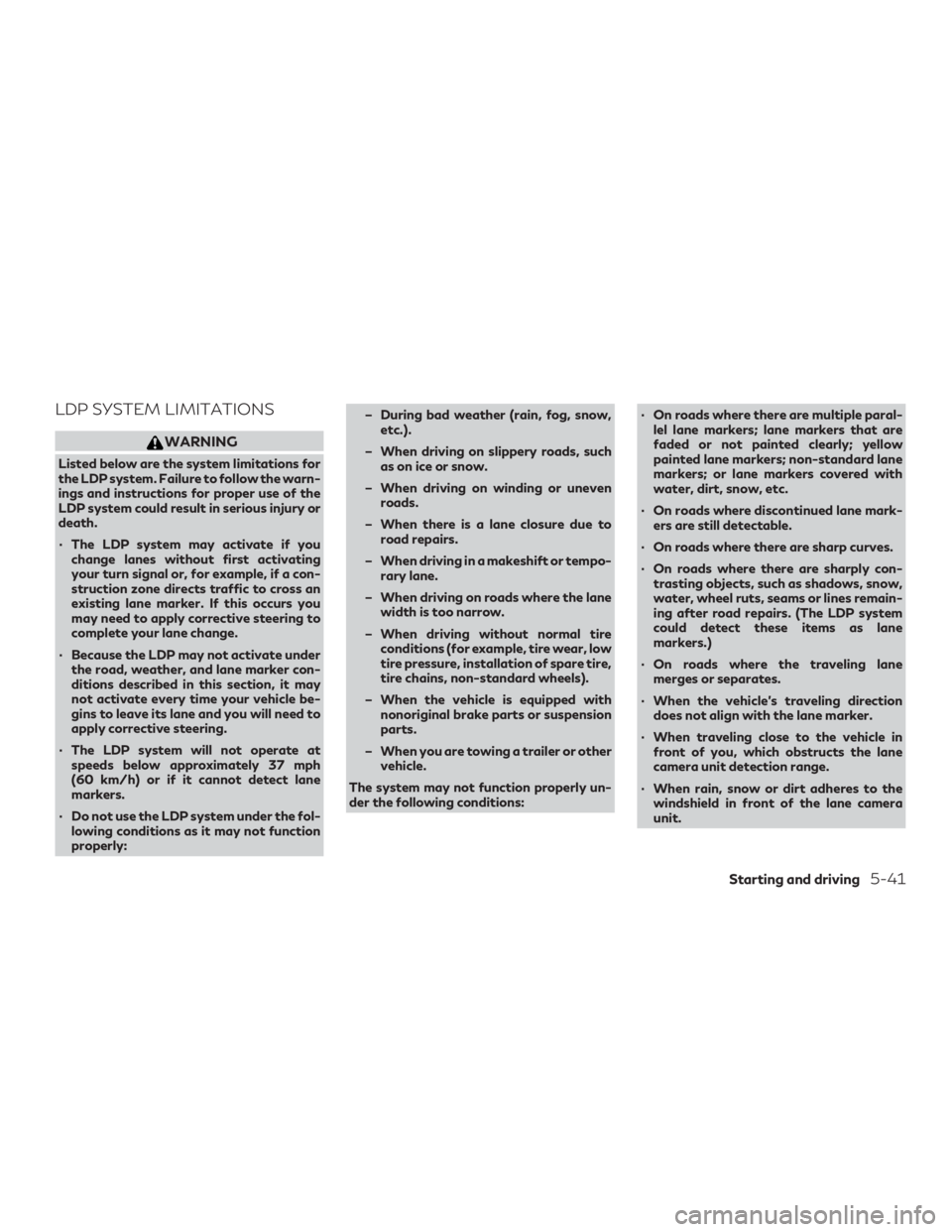
LDP SYSTEM LIMITATIONS
WARNING
Listed below are the system limitations for
the LDP system. Failure to follow the warn-
ings and instructions for proper use of the
LDP system could result in serious injury or
death.
∙ The LDP system may activate if youchange lanes without first activating
your turn signal or, for example, if a con-
struction zone directs traffic to cross an
existing lane marker. If this occurs you
may need to apply corrective steering to
complete your lane change.
∙ Because the LDP may not activate under the road, weather, and lane marker con-
ditions described in this section, it may
not activate every time your vehicle be-
gins to leave its lane and you will need to
apply corrective steering.
∙ The LDP system will not operate at speeds below approximately 37 mph
(60 km/h) or if it cannot detect lane
markers.
∙ Do not use the LDP system under the fol- lowing conditions as it may not function
properly: – During bad weather (rain, fog, snow,
etc.).
– When driving on slippery roads, such as on ice or snow.
– When driving on winding or uneven roads.
– When there is a lane closure due to road repairs.
– When driving in a makeshift or tempo- rary lane.
– When driving on roads where the lane width is too narrow.
– When driving without normal tire conditions (for example, tire wear, low
tire pressure, installation of spare tire,
tire chains, non-standard wheels).
– When the vehicle is equipped with nonoriginal brake parts or suspension
parts.
– When you are towing a trailer or other vehicle.
The system may not function properly un-
der the following conditions: ∙ On roads where there are multiple paral-
lel lane markers; lane markers that are
faded or not painted clearly; yellow
painted lane markers; non-standard lane
markers; or lane markers covered with
water, dirt, snow, etc.
∙ On roads where discontinued lane mark- ers are still detectable.
∙ On roads where there are sharp curves.
∙ On roads where there are sharply con- trasting objects, such as shadows, snow,
water, wheel ruts, seams or lines remain-
ing after road repairs. (The LDP system
could detect these items as lane
markers.)
∙ On roads where the traveling lane merges or separates.
∙ When the vehicle’s traveling direction does not align with the lane marker.
∙ When traveling close to the vehicle in front of you, which obstructs the lane
camera unit detection range.
∙ When rain, snow or dirt adheres to the windshield in front of the lane camera
unit.
Starting and driving5-41
Page 317 of 573

– On roads where there are sharply con-trasting objects, such as shadows,
snow, water, wheel ruts, seams or
lines remaining after road repairs.
– On roads where the traveling lane merges or separates.
– When the vehicle’s traveling direction does not align with the lane markers.
– When traveling close to the vehicle in front of you, which obstructs the lane
camera unit detection range.
– When rain, snow or dirt adheres to the windshield in front of a lane camera
unit.
– When the headlights are not bright due to dirt on the lens or if aiming is
not adjusted properly.
– When strong light enters a lane cam- era unit (e.g., light directly shines on
the front of the vehicle at sunrise or
sunset).
– When a sudden change in brightness occurs (e.g., when the vehicle enters or
exits a tunnel or under a bridge). ∙ Do not use the BSI system under the fol-
lowing conditions because the system
may not function properly:
– During bad weather (e.g., rain, fog, snow, etc.).
– When driving on slippery roads, such as on ice or snow, etc.
– When driving on winding or uneven roads.
– When there is a lane closure due to road repairs.
– When driving in a makeshift lane.
– When driving on roads where the lane width is too narrow.
– When driving with a tire that is not within normal tire conditions (e.g., tire
wear, low tire pressure, installation of
spare tire, tire chains, nonstandard
wheels).
– When the vehicle is equipped with non-original brake parts or suspen-
sion parts.
∙ Do not use the BSI system when towing a trailer. ∙ Excessive noise (e.g., audio system vol-
ume, open vehicle window) will interfere
with the chime sound, and it may not be
heard.
5-58Starting and driving
Page 392 of 573
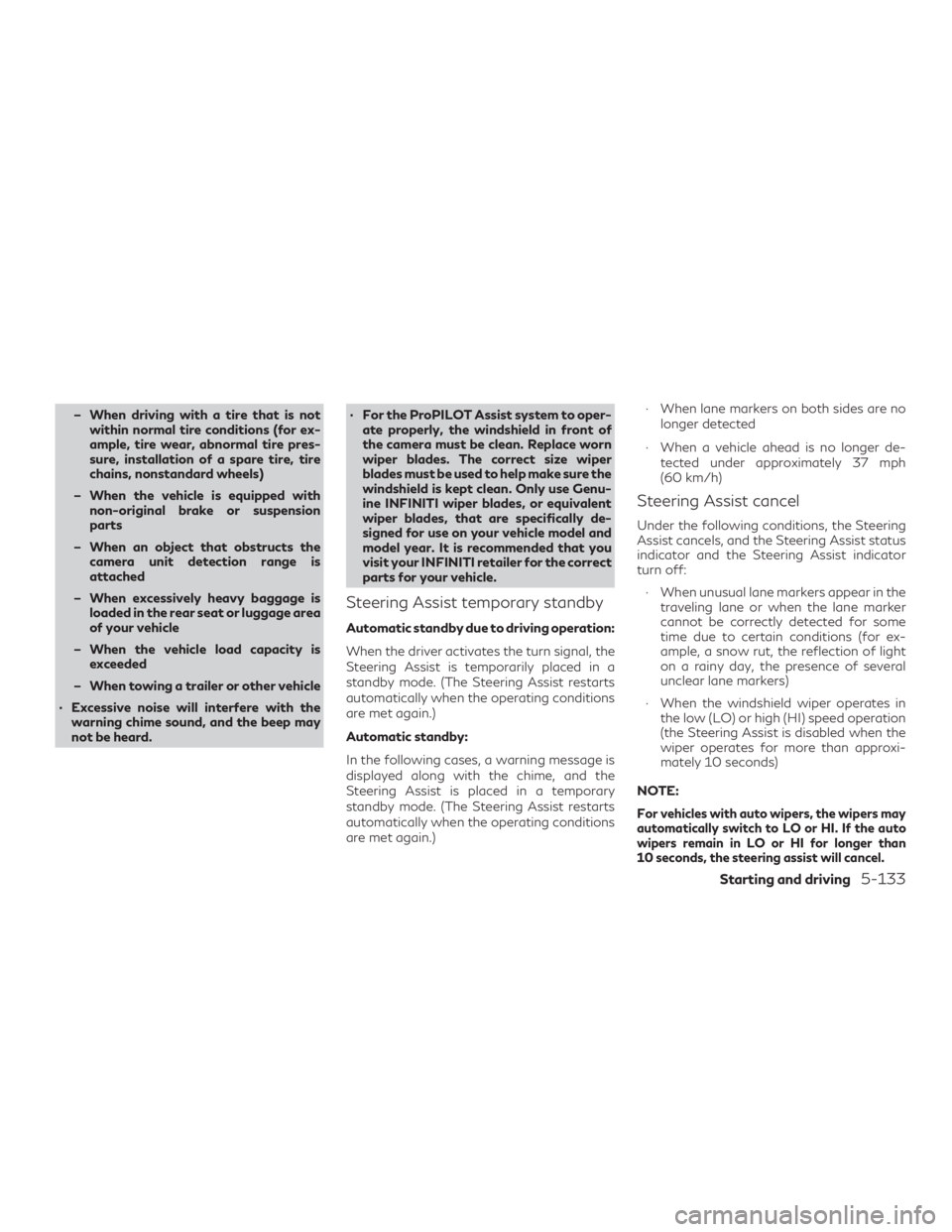
– When driving with a tire that is notwithin normal tire conditions (for ex-
ample, tire wear, abnormal tire pres-
sure, installation of a spare tire, tire
chains, nonstandard wheels)
– When the vehicle is equipped with non-original brake or suspension
parts
– When an object that obstructs the camera unit detection range is
attached
– When excessively heavy baggage is loaded in the rear seat or luggage area
of your vehicle
– When the vehicle load capacity is exceeded
– When towing a trailer or other vehicle
∙ Excessive noise will interfere with the warning chime sound, and the beep may
not be heard. ∙ For the ProPILOT Assist system to oper-
ate properly, the windshield in front of
the camera must be clean. Replace worn
wiper blades. The correct size wiper
blades must be used to help make sure the
windshield is kept clean. Only use Genu-
ine INFINITI wiper blades, or equivalent
wiper blades, that are specifically de-
signed for use on your vehicle model and
model year. It is recommended that you
visit your INFINITI retailer for the correct
parts for your vehicle.
Steering Assist temporary standby
Automatic standby due to driving operation:
When the driver activates the turn signal, the
Steering Assist is temporarily placed in a
standby mode. (The Steering Assist restarts
automatically when the operating conditions
are met again.)
Automatic standby:
In the following cases, a warning message is
displayed along with the chime, and the
Steering Assist is placed in a temporary
standby mode. (The Steering Assist restarts
automatically when the operating conditions
are met again.) ∙ When lane markers on both sides are no
longer detected
∙ When a vehicle ahead is no longer de- tected under approximately 37 mph
(60 km/h)
Steering Assist cancel
Under the following conditions, the Steering
Assist cancels, and the Steering Assist status
indicator and the Steering Assist indicator
turn off:
∙ When unusual lane markers appear in the traveling lane or when the lane marker
cannot be correctly detected for some
time due to certain conditions (for ex-
ample, a snow rut, the reflection of light
on a rainy day, the presence of several
unclear lane markers)
∙ When the windshield wiper operates in the low (LO) or high (HI) speed operation
(the Steering Assist is disabled when the
wiper operates for more than approxi-
mately 10 seconds)
NOTE:
For vehicles with auto wipers, the wipers may
automatically switch to LO or HI. If the auto
wipers remain in LO or HI for longer than
10 seconds, the steering assist will cancel.
Starting and driving5-133
Page 439 of 573
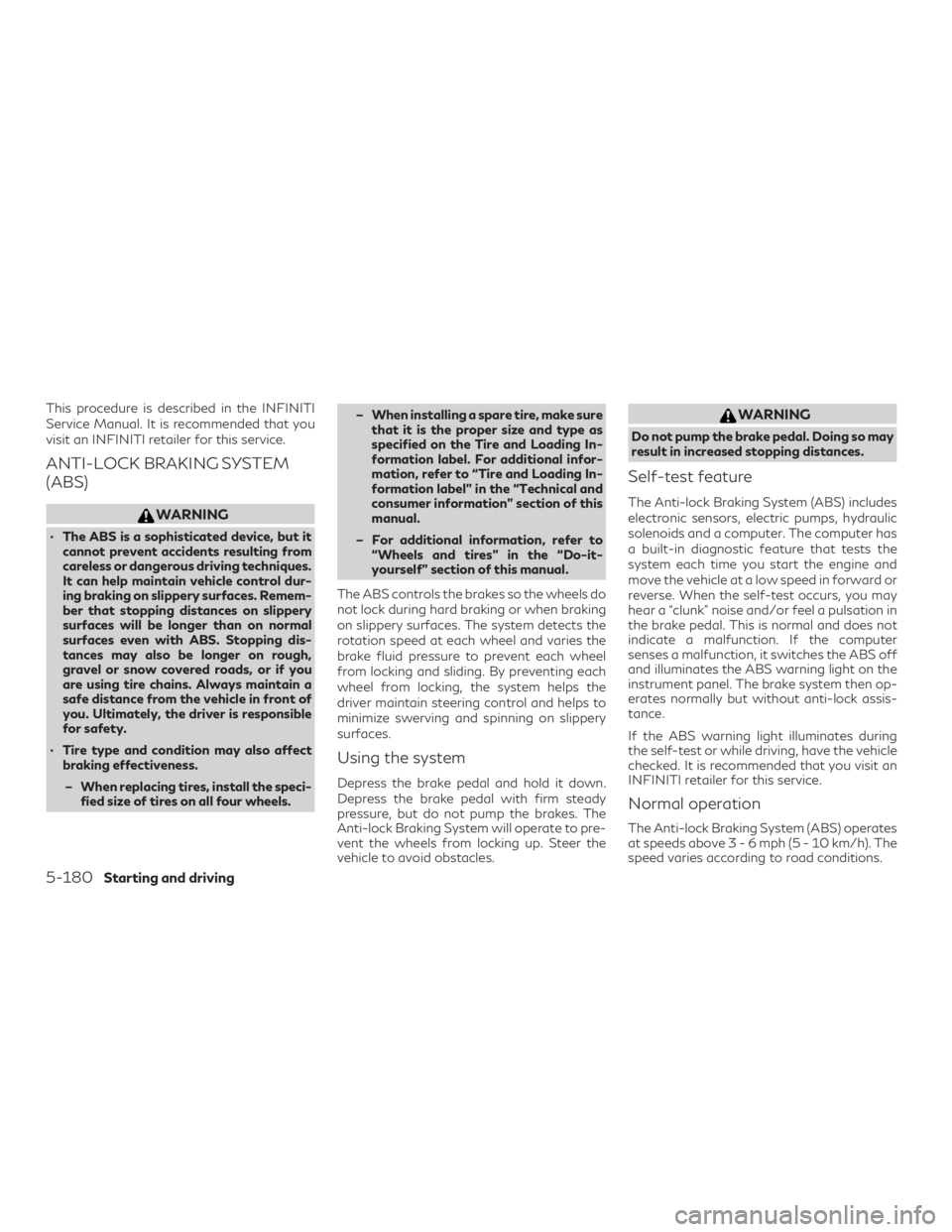
This procedure is described in the INFINITI
Service Manual. It is recommended that you
visit an INFINITI retailer for this service.
ANTI-LOCK BRAKING SYSTEM
(ABS)
WARNING
∙ The ABS is a sophisticated device, but itcannot prevent accidents resulting from
careless or dangerous driving techniques.
It can help maintain vehicle control dur-
ing braking on slippery surfaces. Remem-
ber that stopping distances on slippery
surfaces will be longer than on normal
surfaces even with ABS. Stopping dis-
tances may also be longer on rough,
gravel or snow covered roads, or if you
are using tire chains. Always maintain a
safe distance from the vehicle in front of
you. Ultimately, the driver is responsible
for safety.
∙ Tire type and condition may also affect braking effectiveness.
– When replacing tires, install the speci- fied size of tires on all four wheels. – When installing a spare tire, make sure
that it is the proper size and type as
specified on the Tire and Loading In-
formation label. For additional infor-
mation, refer to “Tire and Loading In-
formation label” in the “Technical and
consumer information” section of this
manual.
– For additional information, refer to “Wheels and tires” in the “Do-it-
yourself” section of this manual.
The ABS controls the brakes so the wheels do
not lock during hard braking or when braking
on slippery surfaces. The system detects the
rotation speed at each wheel and varies the
brake fluid pressure to prevent each wheel
from locking and sliding. By preventing each
wheel from locking, the system helps the
driver maintain steering control and helps to
minimize swerving and spinning on slippery
surfaces.
Using the system
Depress the brake pedal and hold it down.
Depress the brake pedal with firm steady
pressure, but do not pump the brakes. The
Anti-lock Braking System will operate to pre-
vent the wheels from locking up. Steer the
vehicle to avoid obstacles.
WARNING
Do not pump the brake pedal. Doing so may
result in increased stopping distances.
Self-test feature
The Anti-lock Braking System (ABS) includes
electronic sensors, electric pumps, hydraulic
solenoids and a computer. The computer has
a built-in diagnostic feature that tests the
system each time you start the engine and
move the vehicle at a low speed in forward or
reverse. When the self-test occurs, you may
hear a “clunk” noise and/or feel a pulsation in
the brake pedal. This is normal and does not
indicate a malfunction. If the computer
senses a malfunction, it switches the ABS off
and illuminates the ABS warning light on the
instrument panel. The brake system then op-
erates normally but without anti-lock assis-
tance.
If the ABS warning light illuminates during
the self-test or while driving, have the vehicle
checked. It is recommended that you visit an
INFINITI retailer for this service.
Normal operation
The Anti-lock Braking System (ABS) operates
at speeds above3-6mph(5-10km/h). The
speed varies according to road conditions.
5-180Starting and driving
Page 441 of 573
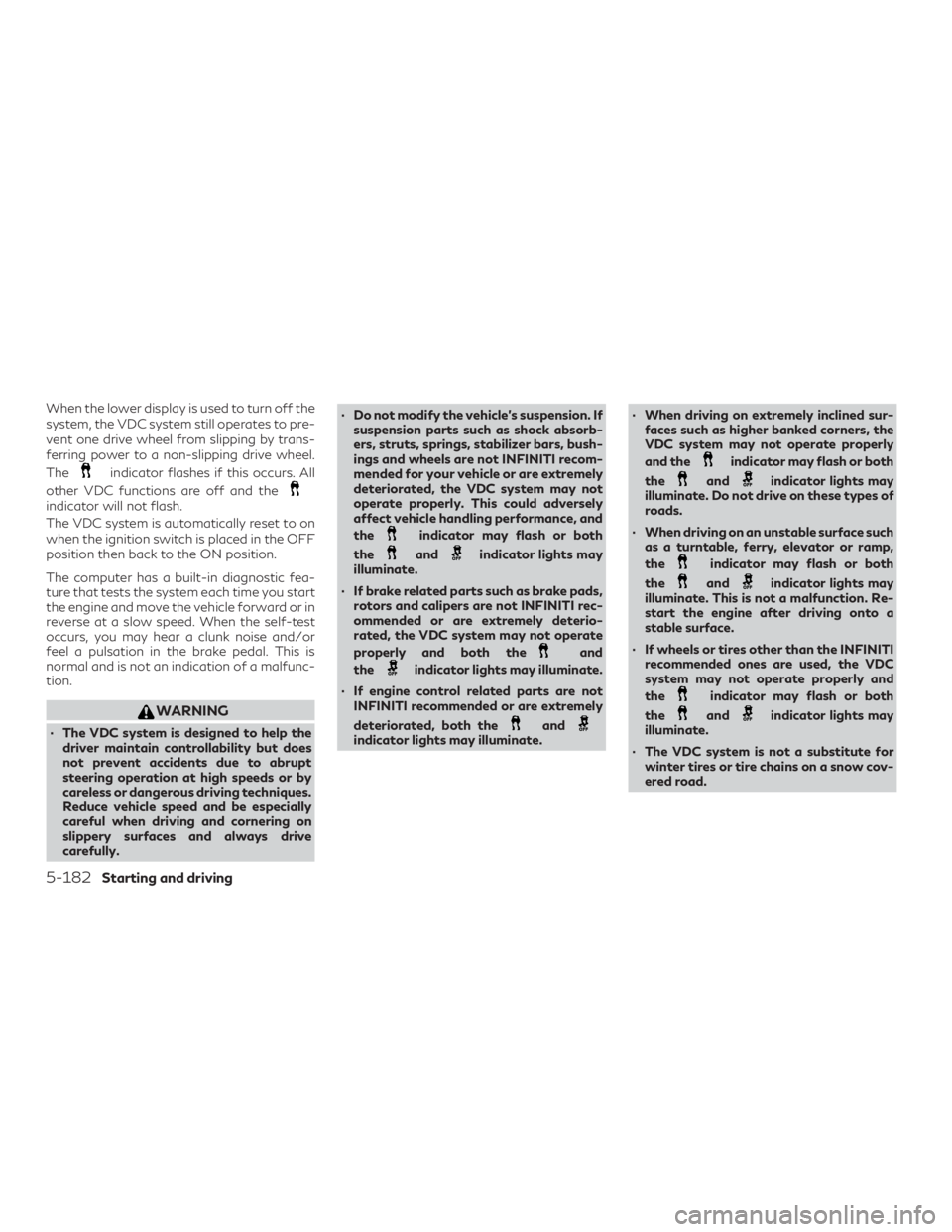
When the lower display is used to turn off the
system, the VDC system still operates to pre-
vent one drive wheel from slipping by trans-
ferring power to a non-slipping drive wheel.
The
indicator flashes if this occurs. All
other VDC functions are off and the
indicator will not flash.
The VDC system is automatically reset to on
when the ignition switch is placed in the OFF
position then back to the ON position.
The computer has a built-in diagnostic fea-
ture that tests the system each time you start
the engine and move the vehicle forward or in
reverse at a slow speed. When the self-test
occurs, you may hear a clunk noise and/or
feel a pulsation in the brake pedal. This is
normal and is not an indication of a malfunc-
tion.
WARNING
∙ The VDC system is designed to help the driver maintain controllability but does
not prevent accidents due to abrupt
steering operation at high speeds or by
careless or dangerous driving techniques.
Reduce vehicle speed and be especially
careful when driving and cornering on
slippery surfaces and always drive
carefully. ∙ Do not modify the vehicle’s suspension. If
suspension parts such as shock absorb-
ers, struts, springs, stabilizer bars, bush-
ings and wheels are not INFINITI recom-
mended for your vehicle or are extremely
deteriorated, the VDC system may not
operate properly. This could adversely
affect vehicle handling performance, and
the
indicator may flash or both
the
andindicator lights may
illuminate.
∙ If brake related parts such as brake pads, rotors and calipers are not INFINITI rec-
ommended or are extremely deterio-
rated, the VDC system may not operate
properly and both the
and
the
indicator lights may illuminate.
∙ If engine control related parts are not INFINITI recommended or are extremely
deteriorated, both the
andindicator lights may illuminate. ∙ When driving on extremely inclined sur-
faces such as higher banked corners, the
VDC system may not operate properly
and the
indicator may flash or both
the
andindicator lights may
illuminate. Do not drive on these types of
roads.
∙ When driving on an unstable surface such as a turntable, ferry, elevator or ramp,
the
indicator may flash or both
the
andindicator lights may
illuminate. This is not a malfunction. Re-
start the engine after driving onto a
stable surface.
∙ If wheels or tires other than the INFINITI recommended ones are used, the VDC
system may not operate properly and
the
indicator may flash or both
the
andindicator lights may
illuminate.
∙ The VDC system is not a substitute for winter tires or tire chains on a snow cov-
ered road.
5-182Starting and driving
Page 442 of 573
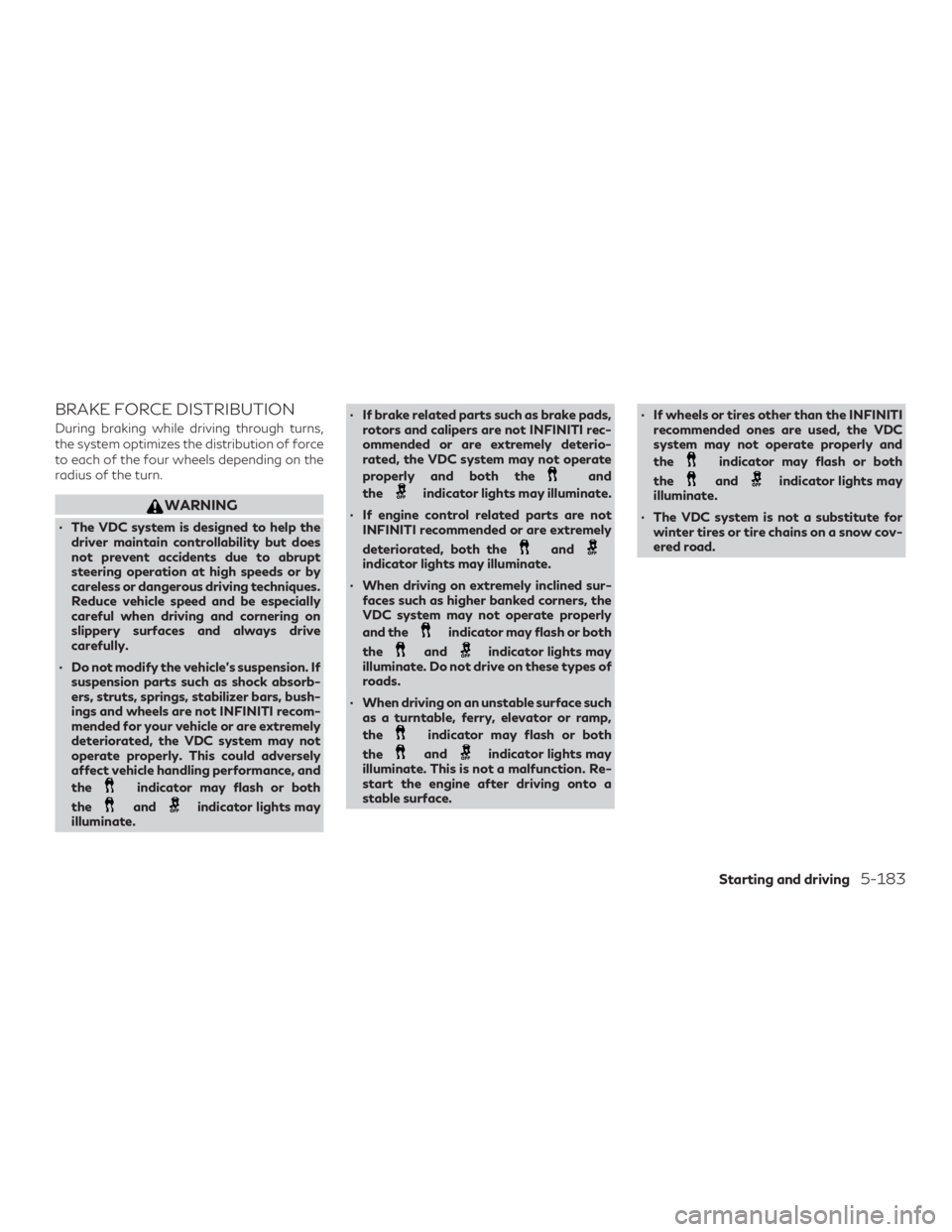
BRAKE FORCE DISTRIBUTION
During braking while driving through turns,
the system optimizes the distribution of force
to each of the four wheels depending on the
radius of the turn.
WARNING
∙ The VDC system is designed to help thedriver maintain controllability but does
not prevent accidents due to abrupt
steering operation at high speeds or by
careless or dangerous driving techniques.
Reduce vehicle speed and be especially
careful when driving and cornering on
slippery surfaces and always drive
carefully.
∙ Do not modify the vehicle’s suspension. If suspension parts such as shock absorb-
ers, struts, springs, stabilizer bars, bush-
ings and wheels are not INFINITI recom-
mended for your vehicle or are extremely
deteriorated, the VDC system may not
operate properly. This could adversely
affect vehicle handling performance, and
the
indicator may flash or both
the
andindicator lights may
illuminate. ∙ If brake related parts such as brake pads,
rotors and calipers are not INFINITI rec-
ommended or are extremely deterio-
rated, the VDC system may not operate
properly and both the
and
the
indicator lights may illuminate.
∙ If engine control related parts are not INFINITI recommended or are extremely
deteriorated, both the
andindicator lights may illuminate.
∙ When driving on extremely inclined sur- faces such as higher banked corners, the
VDC system may not operate properly
and the
indicator may flash or both
the
andindicator lights may
illuminate. Do not drive on these types of
roads.
∙ When driving on an unstable surface such as a turntable, ferry, elevator or ramp,
the
indicator may flash or both
the
andindicator lights may
illuminate. This is not a malfunction. Re-
start the engine after driving onto a
stable surface. ∙ If wheels or tires other than the INFINITI
recommended ones are used, the VDC
system may not operate properly and
the
indicator may flash or both
the
andindicator lights may
illuminate.
∙ The VDC system is not a substitute for winter tires or tire chains on a snow cov-
ered road.
Starting and driving5-183
Page 451 of 573
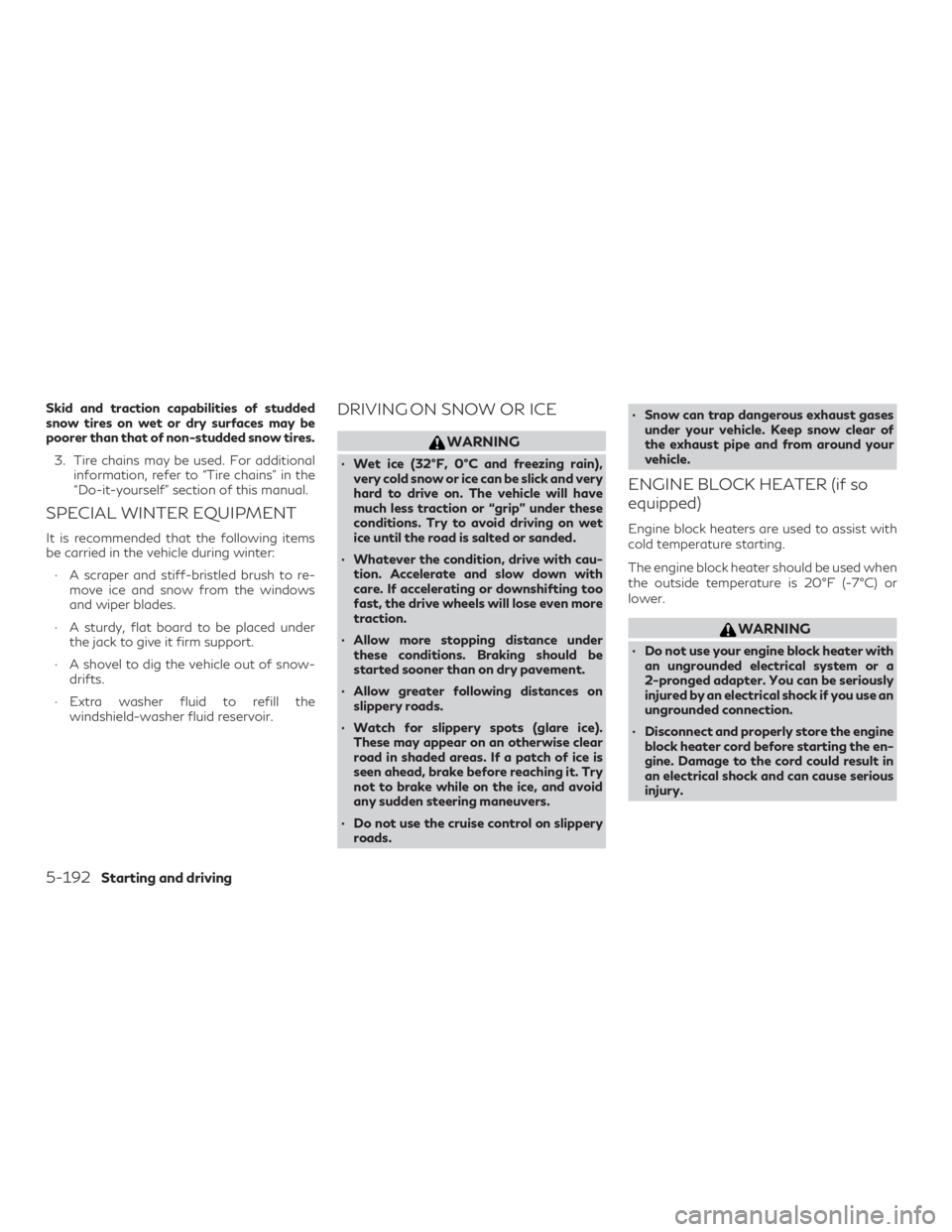
Skid and traction capabilities of studded
snow tires on wet or dry surfaces may be
poorer than that of non-studded snow tires.3. Tire chains may be used. For additional information, refer to “Tire chains” in the
“Do-it-yourself” section of this manual.
SPECIAL WINTER EQUIPMENT
It is recommended that the following items
be carried in the vehicle during winter:
∙ A scraper and stiff-bristled brush to re- move ice and snow from the windows
and wiper blades.
∙ A sturdy, flat board to be placed under the jack to give it firm support.
∙ A shovel to dig the vehicle out of snow- drifts.
∙ Extra washer fluid to refill the windshield-washer fluid reservoir.
DRIVING ON SNOW OR ICE
WARNING
∙ Wet ice (32°F, 0°C and freezing rain),very cold snow or ice can be slick and very
hard to drive on. The vehicle will have
much less traction or “grip” under these
conditions. Try to avoid driving on wet
ice until the road is salted or sanded.
∙ Whatever the condition, drive with cau- tion. Accelerate and slow down with
care. If accelerating or downshifting too
fast, the drive wheels will lose even more
traction.
∙ Allow more stopping distance under these conditions. Braking should be
started sooner than on dry pavement.
∙ Allow greater following distances on slippery roads.
∙ Watch for slippery spots (glare ice). These may appear on an otherwise clear
road in shaded areas. If a patch of ice is
seen ahead, brake before reaching it. Try
not to brake while on the ice, and avoid
any sudden steering maneuvers.
∙ Do not use the cruise control on slippery roads. ∙ Snow can trap dangerous exhaust gases
under your vehicle. Keep snow clear of
the exhaust pipe and from around your
vehicle.
ENGINE BLOCK HEATER (if so
equipped)
Engine block heaters are used to assist with
cold temperature starting.
The engine block heater should be used when
the outside temperature is 20°F (-7°C) or
lower.
WARNING
∙ Do not use your engine block heater withan ungrounded electrical system or a
2-pronged adapter. You can be seriously
injured by an electrical shock if you use an
ungrounded connection.
∙ Disconnect and properly store the engine block heater cord before starting the en-
gine. Damage to the cord could result in
an electrical shock and can cause serious
injury.
5-192Starting and driving
Page 464 of 573
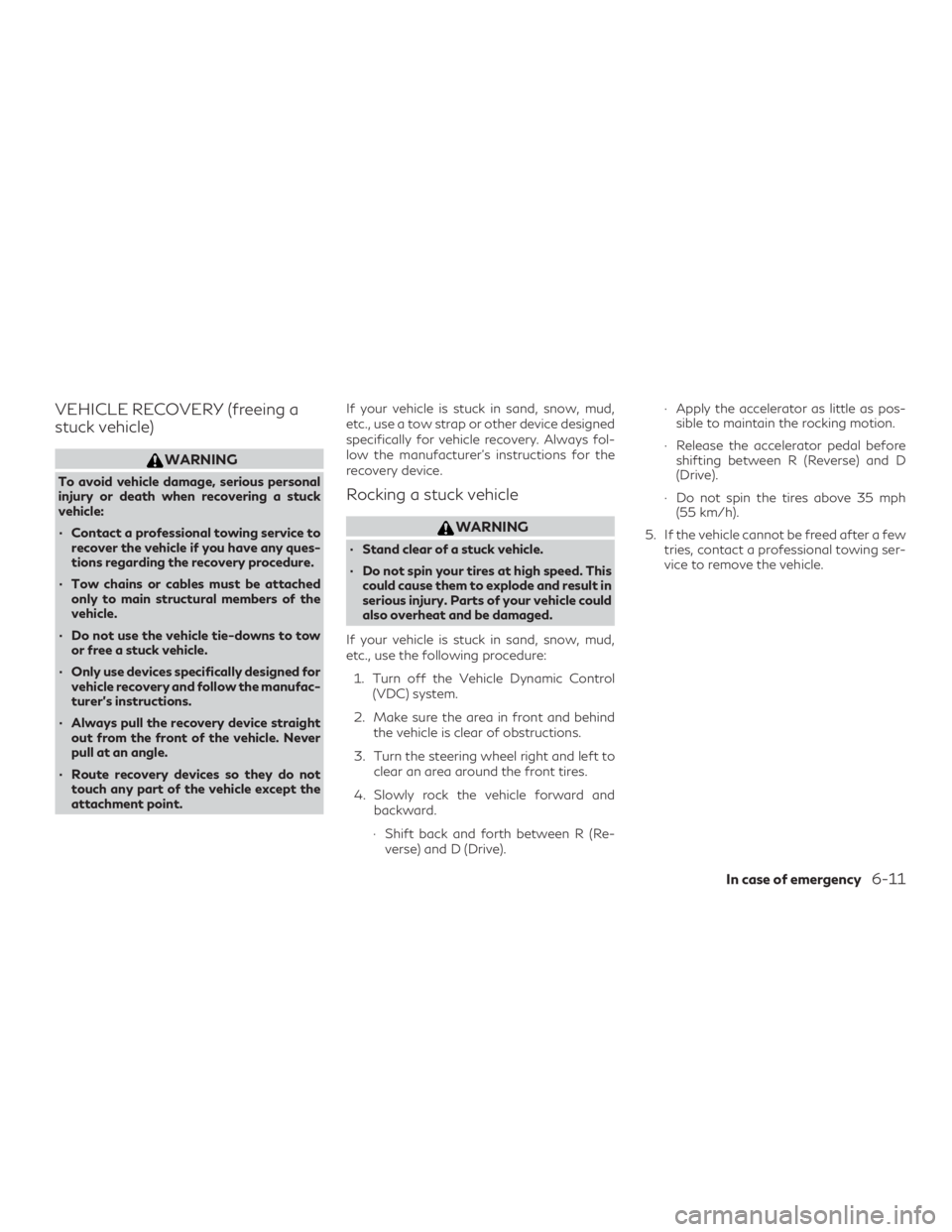
VEHICLE RECOVERY (freeing a
stuck vehicle)
WARNING
To avoid vehicle damage, serious personal
injury or death when recovering a stuck
vehicle:
∙ Contact a professional towing service torecover the vehicle if you have any ques-
tions regarding the recovery procedure.
∙ Tow chains or cables must be attached only to main structural members of the
vehicle.
∙ Do not use the vehicle tie-downs to tow or free a stuck vehicle.
∙ Only use devices specifically designed for vehicle recovery and follow the manufac-
turer’s instructions.
∙ Always pull the recovery device straight out from the front of the vehicle. Never
pull at an angle.
∙ Route recovery devices so they do not touch any part of the vehicle except the
attachment point. If your vehicle is stuck in sand, snow, mud,
etc., use a tow strap or other device designed
specifically for vehicle recovery. Always fol-
low the manufacturer’s instructions for the
recovery device.Rocking a stuck vehicle
WARNING
∙ Stand clear of a stuck vehicle.
∙ Do not spin your tires at high speed. This
could cause them to explode and result in
serious injury. Parts of your vehicle could
also overheat and be damaged.
If your vehicle is stuck in sand, snow, mud,
etc., use the following procedure: 1. Turn off the Vehicle Dynamic Control (VDC) system.
2. Make sure the area in front and behind the vehicle is clear of obstructions.
3. Turn the steering wheel right and left to clear an area around the front tires.
4. Slowly rock the vehicle forward and backward.
∙ Shift back and forth between R (Re- verse) and D (Drive). ∙ Apply the accelerator as little as pos-
sible to maintain the rocking motion.
∙ Release the accelerator pedal before shifting between R (Reverse) and D
(Drive).
∙ Do not spin the tires above 35 mph (55 km/h).
5. If the vehicle cannot be freed after a few tries, contact a professional towing ser-
vice to remove the vehicle.
In case of emergency6-11